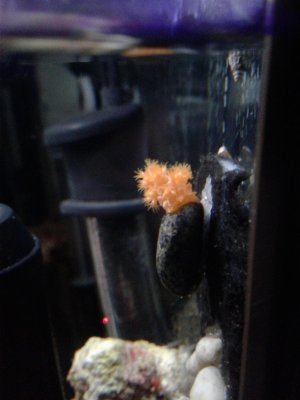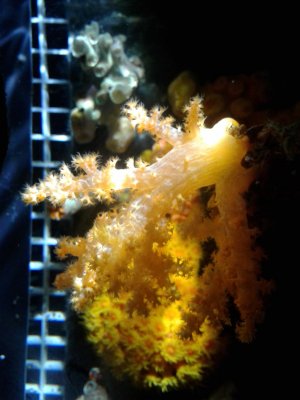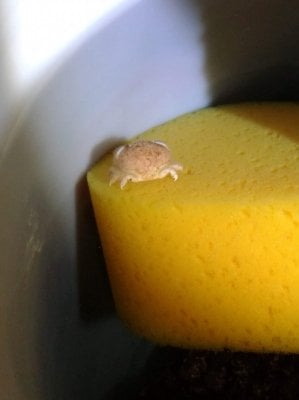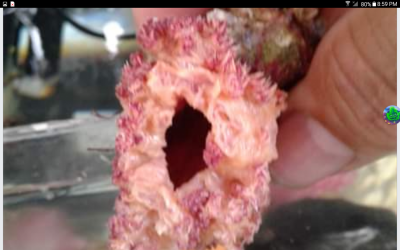After recently using a product - I will categorically say - never again. I dont think there is any way to increase 'diversity' or anything else by adding bacteria - except nitrates..... I can try to explain this more if you want - but I was just answering your oP
Navigation
Install the app
How to install the app on iOS
Follow along with the video below to see how to install our site as a web app on your home screen.
Note: This feature may not be available in some browsers.
More options
You are using an out of date browser. It may not display this or other websites correctly.
You should upgrade or use an alternative browser.
You should upgrade or use an alternative browser.
Bacteria maintenance. What do you dose?
- Thread starter Rick Gaas
- Start date
- Tagged users None
I think an issue is that formal references come from natural studies and not tank ones. Attribution errors are a risk there. *of course no harm in anyone generating tank specific data/need to start somewhere thats for sure but after tank specific data is analyzed it w be amazing to see how sustained changes are made, then factored back to some change in production volume or quality for our display tanks.
In the aquarium trade - its a new fad - like bottled bacteria (was) IMHO. In the wild - diversity is great - in a tank - it might not be - right? I mean - in a natural ecosystem - of course - diversity makes sense - we dont want all the apex predators killed - or 99% of the bacteria.I'm sure you're aware of the century or so of Ecology research that has generally found diversity increases productivity, resilience, and stability... But other readers may not be.
I appreciate your calls for data to support this in the case of aquariums, and agree there are lots of unknowns here.
But we should be clear that it's not as if diversity was some new fad (like bottled bacteria). Ecologists value diversity in general for good and well established reasons.
In a tank - which is a highly controlled environment - with filters, nutrient export, etc etc etc - mixtures of fish from all over the world and different ecosystems - no one knows.
So - though people 'claim' to create diversity - I would be interested in your experiments if you took some samples from @Paul B - and compared his tank (which is supposedly diverse) with others. And which bacteria you see in both. This is not a critique of @Paul B - of course.
- Joined
- Oct 6, 2018
- Messages
- 34
- Reaction score
- 53
Dr Tim’s. Once or twice when the tank is first set up. After that bacteria should find its own balance. Any fish or coral will come with its own unique biome, adding diversity to the tanks bacterial diversity. If it’s not broken I don’t fix it, “dosing” bacteria seems like a waste of time and money.
- Joined
- Oct 6, 2018
- Messages
- 34
- Reaction score
- 53
Theoretically one could run a bacteria free tank, if they could manage the ammonia created. Growing plants hydroponically is similar, some people introduce beneficial bacteria to aid growth, while other methods kill all bacteria in order to control the exact nutrients delivered. Obviously in an aquarium bacteria plays a major roll, but adding bacteria just to add it can’t be efficient. If a certain bacteria doesn’t find food and a place to exist it’ll just die. I figure the bacteria that finds it’s way into my tank via frags, fish, live rock etc and survives and grows are the only bacteria I need. And let’s not forget the bacteria and microbes that live all around us, all the time will also find it’s way into our tanks.In the aquarium trade - its a new fad - like bottled bacteria (was) IMHO. In the wild - diversity is great - in a tank - it might not be - right? I mean - in a natural ecosystem - of course - diversity makes sense - we dont want all the apex predators killed - or 99% of the bacteria.
In a tank - which is a highly controlled environment - with filters, nutrient export, etc etc etc - mixtures of fish from all over the world and different ecosystems - no one knows.
So - though people 'claim' to create diversity - I would be interested in your experiments if you took some samples from @Paul B - and compared his tank (which is supposedly diverse) with others. And which bacteria you see in both. This is not a critique of @Paul B - of course.
- Joined
- Oct 6, 2018
- Messages
- 34
- Reaction score
- 53
100% correct. We have no idea if what is in the bottle is alive, viable, or diverse. If it’s not broken don’t fix it. If your tank has ammonia spikes it’s not because you failed to dose bacteria regularly. After initial cycling I can’t think of a reason to add bottled bacteria.I doubt it’s going to proven, or disproven, any time soon, whether or not bacteria supplements actually help.
I’m more interested in what types of bacteria we are getting in these bottles, if it’s even alive, and if it’s different than what we already have in our tanks.
We need to 23andMe some Zeobak.
Well after reading all 4 pages I’m confused. I have been adding Outbreak due to a problem with a fuzzy looking stuff that I was told was a bad bacteria and the good bacteria would take over this fuzzy stuff. It slowly seems to be doing that. The fuzzy stuff is about 1/4” greyish color and all over rocks and coral, I have never seen it before as nd I have been in this hobby since 1970.
- Joined
- Oct 15, 2019
- Messages
- 402
- Reaction score
- 1,671
Paul was kind enough to provide a sample, we discuss it in his tank thread and another (I can link it when I'm on a PC)In the aquarium trade - its a new fad - like bottled bacteria (was) IMHO. In the wild - diversity is great - in a tank - it might not be - right? I mean - in a natural ecosystem - of course - diversity makes sense - we dont want all the apex predators killed - or 99% of the bacteria.
In a tank - which is a highly controlled environment - with filters, nutrient export, etc etc etc - mixtures of fish from all over the world and different ecosystems - no one knows.
So - though people 'claim' to create diversity - I would be interested in your experiments if you took some samples from @Paul B - and compared his tank (which is supposedly diverse) with others. And which bacteria you see in both. This is not a critique of @Paul B - of course.
Short answer is older tanks tend to be less diverse, while Paul's is highly diverse for it's age. I think I estimated his tank has the avg diversity of a 5 yr old tank or so. Also showed different families at high levels than in the average tank.
Nothing
To see these attach, rare. On the Internet very few photos document this. Bacteria one key to success with these frags.
1 of 20 in house frags


- Joined
- Aug 7, 2017
- Messages
- 2,685
- Reaction score
- 3,911
Gonna try a couple different brands (smallest size available) just to introduce a couple different strains to my reefs.
Cheers! Mark
Cheers! Mark
- Joined
- Oct 25, 2018
- Messages
- 650
- Reaction score
- 1,105
Wait people dose bacteria regularly? I just threw my lil ecosystem together and boom life has emerged (took me a literal year and a half to get coral to live though). I tried dosing a little of this swanky bottle of stuff that I don't remember what it was called when my beloved aunt overfed my tank (bless the bristle worms) and I'm not sure if it did much. Do people really need to dose that stuff on a regular basis? My tank runs fine with all the weird critters and coral I have.
- Joined
- Oct 25, 2018
- Messages
- 650
- Reaction score
- 1,105
That crab is absolutely adorable. Do you know what it is called? I'd love one but I bet it's a specialized one that hosts your Dendronephthya. I have too many crustaceans as it is. I also think it is amazing that you are having so much success with your coral. I have never really seen anyone else keep them alive for more than a month or so. You are paving the way for science my friend. Keep up the good work!!!
- Joined
- Oct 6, 2018
- Messages
- 34
- Reaction score
- 53
Have you noticed a difference in “old” vs “new” tanks (aside from the diversity)? Is there a health difference or a difference in coral growth? Does the tank look different? Algae growth differences? I know it’s all anecdotal at this point, but do you think one or the other is “better”?Paul was kind enough to provide a sample, we discuss it in his tank thread and another (I can link it when I'm on a PC)
Short answer is older tanks tend to be less diverse, while Paul's is highly diverse for it's age. I think I estimated his tank has the avg diversity of a 5 yr old tank or so. Also showed different families at high levels than in the average tank.
- Joined
- Aug 1, 2019
- Messages
- 1,046
- Reaction score
- 888
dr tims waste away for my ultra low. . I run 5 nitrate .02 phosphate.
. I run 5 nitrate .02 phosphate.
- Joined
- Sep 28, 2019
- Messages
- 1,637
- Reaction score
- 1,094
Could this reasoning be why my tank, after a move and removal of a 2 year old sandbed, now has a massive gha/rha outbreak that I am having a hard time controlling, let alone reducing?Bottle bac sellers are also profiting wildly because there are no published articles about surface area proofing. Tales and guessing abound about what bacteria need or don’t need from us to thrive, and they have something for peace of mind $.
For example, it has been said for no less than 25 years by all reefers that we cannot instantly remove a sandbed without ramp down. The live rock wouldn’t have time to take on more bac (as if open spaces exist uncolonized unregulated by water shear etc)
If you start a poll, even 98% will claim it nowadays
It’s not how surface area works, or self regulates, the opposite simple fact is true: if a given # of live rock can run a system stand alone, then removing all incidental surface area surrounding it doesn’t weaken the filtration capacity of the remaining live rock. We’ve been fed the Lamarckian version of reef microbiology, so now we buy bottle bac just in case.
In the sand rinse thread we remove full sandbeds instantly, measuring the impacts of the same bioload now just ran by a chunk of rocks. We measured with mindstream digital, not a guess between slight green or yellow.
Reef tanks can always handle waste ammonia from common living creatures. If a given set of rocks can run twenty two fish, and we’ve only started with ten, then adding the other twelve doesn’t cause an ammonia spike, surfaces don’t ramp up. If it’s been submerged in a reef tank, it’s got total bac coverage
We measured with living fish after tank transfers for four years running, no ammonia spikes as live rock does not take on replacement bacteria when surrounding surface area is removed
The remaining surface area is either enough or it isn’t. It’s not possible to have sustained .25 ammonia, events are all doom or they are all success where surface area is in question.
Additionally, anyone here can install ten canister filters on their reef, run them six years, then instantly remove them with no harm to the greater system, and no parameter other than nitrate affected.
We wouldn’t use bottle bac in the sand rinse thread as a matter of human pride.
In my opinion nutrient turnover during moves plus bright full lighting at setup can be a boon to new algae crops but honestly we see gha in both old and new tanks, tanks with precision nutrient control and grazers still get it, people who buy new light setups get it, both bare bottom and sandbed systems get it, in the end I think we just have to kill it off in any iteration it appears vs trace out a cause. Gha is as well adapted to the reef, perhaps better, than corals
We’ve been trained to attribute 100% of gha issues to nutrients, I’ve not found that to be the case. My 5K spectrum metal halide plant lights will cause gha in anyone’s tank here that I shine them in, for example.
Gha is a life expression permanently associated with reefing, we experiment with ways to suppress a life form that is supposed to be present on every reef, in balance, independent from nutrients in the water except for extreme cases like fertilizer runoff zones. Grazers control plants on the reef, reefs don’t starve plants with their pristine readings it’s grazers that keep balance in nature. Any decent Netflix series shows as much heh
Everyone has their preferred methods for gha and some are bottled additives like vibrant which do work.
I'm always an advocate for cleaning out a system of waste, feed for algae, then killing it off. Most people would rather run high waste retention systems (detritus plugging the sand and rocks) and then tinker with the water and hope for a change.
in threads where reefers were willing, we took apart their whole reef, cleaned it, then killed algae directly vs the water column, and did not wait and hope for a change. Its hard to choose a gha method among all that are out there. If the tank is under fifty gallons, an easy amount of water to drain out and catch, work the tank then put water back, then I’ll vote for direct clean and kill and no more allowing a target to flourish.
My main takeaway above is how we're buying thousands of dollars of bottled nitrifiers as a hobby to aid in fish transfers where they'd transfer fine without it, moving tanks home to home doesn't need bac boosting for safety, and maintenance dosing of bac to add diversity just because. While not harmful we're mainly wasting cash on those endeavors just my opinion
We’ve been trained to attribute 100% of gha issues to nutrients, I’ve not found that to be the case. My 5K spectrum metal halide plant lights will cause gha in anyone’s tank here that I shine them in, for example.
Gha is a life expression permanently associated with reefing, we experiment with ways to suppress a life form that is supposed to be present on every reef, in balance, independent from nutrients in the water except for extreme cases like fertilizer runoff zones. Grazers control plants on the reef, reefs don’t starve plants with their pristine readings it’s grazers that keep balance in nature. Any decent Netflix series shows as much heh
Everyone has their preferred methods for gha and some are bottled additives like vibrant which do work.
I'm always an advocate for cleaning out a system of waste, feed for algae, then killing it off. Most people would rather run high waste retention systems (detritus plugging the sand and rocks) and then tinker with the water and hope for a change.
in threads where reefers were willing, we took apart their whole reef, cleaned it, then killed algae directly vs the water column, and did not wait and hope for a change. Its hard to choose a gha method among all that are out there. If the tank is under fifty gallons, an easy amount of water to drain out and catch, work the tank then put water back, then I’ll vote for direct clean and kill and no more allowing a target to flourish.
My main takeaway above is how we're buying thousands of dollars of bottled nitrifiers as a hobby to aid in fish transfers where they'd transfer fine without it, moving tanks home to home doesn't need bac boosting for safety, and maintenance dosing of bac to add diversity just because. While not harmful we're mainly wasting cash on those endeavors just my opinion
Last edited:
one thing I do notice now, when I acclimate corals which are very sensitive in 5 minutes or less I put them in the tank after temperature acclimation first of course. What I do is squeeze one of the sponges full of bacteria(sits in sump) in a container then pour slowly water into the new Coral. Wait a few minutes and I put the new Coral in the tank and no issues they open up within an hour or less if they're Carnation corals anything else takes a few days or a week.


Last edited:
In general I don't dose bacteria. But a couple of years ago I had a bubble algae outbreak and tried Vibrant. My bubble algae disappeared after a couple of months of dosing the Vibrant... and the bubble algae has never come back.
But after the bubble algae disappeared I tried to keep dosing Vibrant as a "maintenance" dose and ended up with Dinos... however at the same time I had decided to also dose Aminos in the form of Red Sea A and B "coral food" as well as Fauna Marine Reef Vitality.
I stopped dosing everything and after several weeks all the Dinos disappeared.
Don't know what conclusion to make about the above...
I have recently set up a new large tank and am using the Prodibio Biodigest and Bioptim, dosing them every two weeks. Avoided a cycle but that also maybe because I moved all my existing live rock to the new tank with the same bioload so wasn't really expecting a cycle anyway.
But after the bubble algae disappeared I tried to keep dosing Vibrant as a "maintenance" dose and ended up with Dinos... however at the same time I had decided to also dose Aminos in the form of Red Sea A and B "coral food" as well as Fauna Marine Reef Vitality.
I stopped dosing everything and after several weeks all the Dinos disappeared.
Don't know what conclusion to make about the above...
I have recently set up a new large tank and am using the Prodibio Biodigest and Bioptim, dosing them every two weeks. Avoided a cycle but that also maybe because I moved all my existing live rock to the new tank with the same bioload so wasn't really expecting a cycle anyway.
Similar threads
- Replies
- 32
- Views
- 960
- Replies
- 3
- Views
- 156
-
- AMS: Article
- Replies
- 42
- Views
- 5,301
- Replies
- 314
- Views
- 24,423
- Replies
- 3
- Views
- 556























